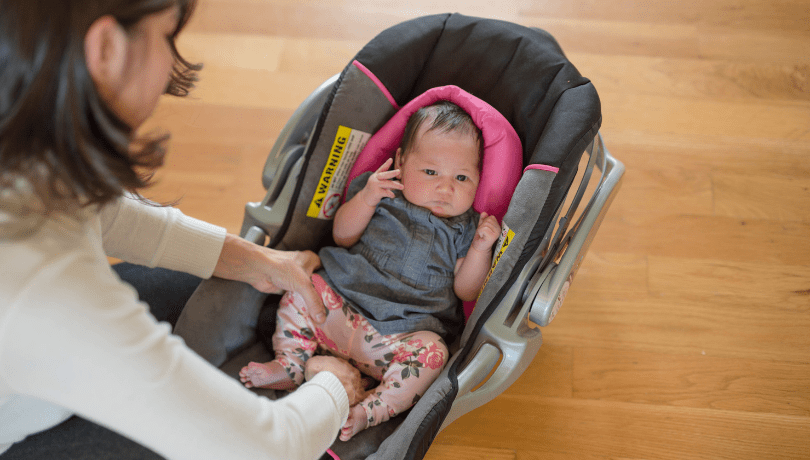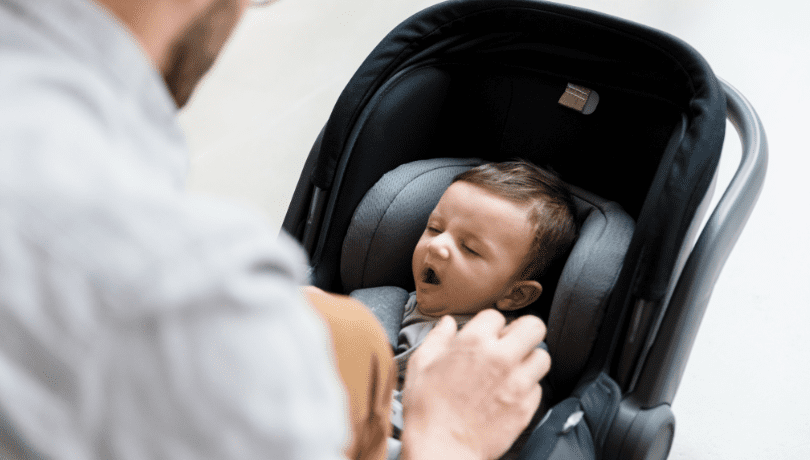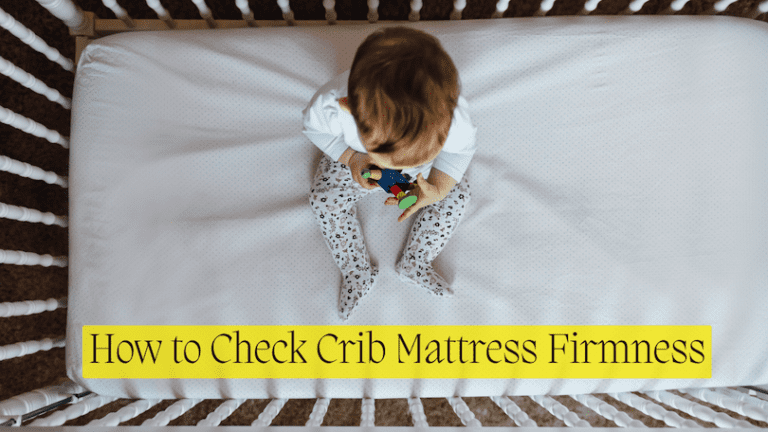Infant Car Seat vs Convertible – Which Is The Best?
Choosing the right car seat for your little one? That’s where you’ll have to pick between an infant car seat vs convertibles.
The main difference? Infant car seats are smaller and are easier to carry than a convertible. On the flip side, convertibles last longer, and adapt to your child’s growing needs.
So, there isn’t really a wrong choice here. Both options are designed to protect your baby from day 1. What you buy purely depends on what you’re looking for. Now, let’s go through their differences in deeper detail with pros and cons and jump into FAQs as well. Here we go.
Table of Contents

Features of Convertible Car Seats (0 to 4 Years)
- You can adapt the convertible seat for infants up to 4 years of age, or until they reach 35 to 40 lbs.
- These can transition from a rear-facing to a forward-facing seat for your newborn as they grow.
- However, unlike a baby capsule or infant car seat, the convertible car seat will only stay in your car.
- As per expert recommendations, you can keep your child rear-facing for almost 2.5 years since convertible seats have ERF or extended rear-facing seats.
- You can also choose from infant convertible seats (0 to 4 years) for a more compact seat. They’re smaller than a regular convertible seat, usually lasting up to 8 or 9 years.
Pros and Cons – Infant Car Seat vs Convertible
Just like every kid is different, so is every family. Your needs and lifestyle greatly impact the car seat you choose. For example, if you like to travel, you need a car seat compatible with multiple bases, travel systems, and strollers.
Recommended Reading: 2 Secure Ways to Install the Infant Car Seat Base
There are many suitable options for infant and convertible seats. So, here are a few things to consider, to make this decision easier:
1. Infant Car Seats

- Portable – The seats can be detached from their bases and used as baby carriers.
- Compatibility – Most infant car seats match well with numerous bases, strollers, and travel systems (know that while they are compatible with different bases, the bases are not universal).
- Design – Infant car seats are designed to protect even the smallest newborns. Features like infant inserts, side impact protection, and a 5-point harness can protect your little ones better.
- Convenient – Easier to secure a baby into their car seat even before putting them inside the car.
Recommended Reading: How to Install an Infant Car Seat Without the Base?
- Short-Lived – Despite having a high upper limit, kids usually outgrow the seat within the first 4 to 5 months.
- Expensive in Due Course – Parents may have to get multiple car seats to make sure they fit their growing baby well. This makes it more expensive with time.
2. Convertible Car Seats

- Longevity – Convertible car seats last longer; until your child is 4 years old or above.
- Versatility – They can be switched to rear-facing or forward-facing car seats. ERF (extending rear-facing) lets your child stay in a rear-facing seat longer.
- Higher Limits – Convertible seats usually have a higher weight and height limit for rear-facing seats – usually from 5 lbs to 120 lbs.
- Cost Effective – More cost-effective in time as they adapt to your growing infant or toddler.
- No Stroller Compatibility – Convertible seats aren’t compatible with travel systems or strollers.
- Not Portable – Convertible seats aren’t portable due to their size and weight. They must be strapped in the car at all times.
- Bulky Design – Initially, the convertible seats may seem bulkier for an infant. They are also more space-consuming and, thus, not suitable for smaller cars.
- Infant Inserts – While some convertible seats may have infant inserts, most do not. It can be concerning for smaller newborns.
Note: Sometimes it’s easier to get your new baby all bundled up and ready in their infant car seat while you’re still in the house. However, since convertibles can’t be carried inside, you must transfer the little one in your arms, stand in the elements, and strap them in carefully before you drive.
In bad weather, convertible car seats get really inconvenient – trust me, I learned the hard way!
When to Switch from Infant Car Seats to Convertibles
Experts recommend that your baby sit in a rear-facing seat until they reach its height or weight limit. After that, you can switch them to a convertible, and this usually happens at around their 4-year mark.
Don’t miss the ‘or’ in the height or weight limit! Reaching either criterion is enough to move your baby to a forward-facing or at least a bigger seat. Most children will hit the recommended height limit first. You can make the switch now!

Still deciding? Look for these signs to identify the right time for the switch:
- Your child has reached the recommended weight limit for the seat, generally around 35 lbs.
- Your child has hit the seat height criteria; generally 30 to 32 inches, or is one inch or less shy of reaching the top of the seat.
- If you have a convertible seat, check to see if the rear-facing seat is suitable until your child hits 30 lbs.
The AAP says to keep your child in rear-facing seats for as long as possible, then transition them to a forward-facing seat with a harness at around 5 to 7 years of age, or based on maturity, and height and weight limits.
Every child is different, so their car seat journey cannot be the same. Follow these safety precautions before making the transition:
- Always refer to the manufacturer’s guide to determine your seat’s highest weight and height limits.
- Read the owner’s manual of the car seat and the vehicle’s manual before installing it correctly.
- Get the shoulder straps right! Regardless of whether you have a rear-facing, forward-facing, or booster seat, you will need to position the straps the right way for maximum safety.
Recommended Reading: When Is My Baby Too Big For Infant Car Seat
Convertible Car Seats: 5 Things to Consider Before Buying
1. Choosing the Right Size
- Newborns often look comically tiny in their convertible car seats. And even though some convertible seats come with infant inserts and padding, they’re not always sufficient for smaller newborns.
- The seat must support the neck and head safely to avoid SIDS or suffocation risks.
2. Budget and Quality
- Expensive doesn’t always mean better. Instead, go for trusted brands with good reviews from real parents. Avoid pre-loved car seats – you can’t ensure their condition or recall status.
- And watch out for fake websites targeting inexperienced parents with cheap prices. The products you receive are often poor-quality or not compliant with US regulations.

Key Tip: Avoid smaller seats – they’ll outgrow them quickly, costing you more as time goes on.
3. Safety Features
- Go for a convertible seat that allows your baby to travel in a rear-facing seat longer. Ensure the safety harness fits your baby comfortably; it shouldn’t be too tight or loose.
- Federally approved car seats are best, and don’t forget to check the crash test scores for safety and performance.
Recommended Reading: Infant Car Seat Crash Test Ratings
4. Proper Recline
- If you’re skipping the infant car seat and buying a convertible one for your newborn, proper head positioning is crucial.
- Since newborns have no head and neck control, never let their heads slump forward in the car seat. Keeping them in a reclined position is best.
5. Considerations for Preemies
- Premature babies (or preemies) can be smaller than your usual newborns. And for them, a car seat with a flat back and removable infant inserts is more appropriate.
- Also, many infant car seats and convertibles have a minimum weight requirement of 4 lbs. So, a premature baby can use such seats if they are at that weight or above.
P.S. It also helps to understand where to place infant car seats or convertibles, especially when you have multiple kids like me. Some parents prefer the driver’s side, while others choose the passenger side, so please ensure you choose for both comfort and safety.
FAQs: Infant Car Seat vs Convertible
1. How Long Can You Use An Infant Car Seat?
1. Typically, most children will reach their height limit for their infant seat long before meeting the weight criteria.
2. Although all seats are different, infant seats can usually accommodate an infant up to 28 to 35 inches in height, and up to 30 lbs in weight.
3. So, if your child is closer to either criterion or is one inch or less shy from reaching the top of the seat, it’s time to switch to a bigger seat.
2. Are Convertible Car Seats Safe For Infants?
Yes, they are. However, you must ensure that your little one fits the weight and height criteria. Even though all convertible seats start as rear-facing seats, they all have different weight criteria.
1. Some seats accommodate newborns and infants starting from 4 to 5 lbs, whereas, some can only accommodate them once they reach 15 lbs. Do keep this in mind before you buy one!
2. Most parents prefer convertible seats because they last longer than infant car seats, even though they’re priced higher and take up more space.
3. Will Convertible Car Seats Fit My Vehicle?
Convertible seats are bigger than a regular bucket seat or infant car seat. Please start them as a rear-facing seat for an infant, and switch them to forward-facing seats as they grow older.
So, yes, they do take up more space than an average infant car seat.
But, please know that convertible seats are compatible with most cars unless you have multiple car seats in the back, or drive a small car.
4. What Costs More: Infant Car Seats or Convertible Car Seats?
1. Convertible seats are more expensive as an initial investment. But they are actually more cost-effective eventually, since they grow with your baby.
2. With infant car seats, you’ll have to switch to a bigger one within 4 to 5 months, depending on your baby’s growth.
Yet, with most convertible seats, you can rest easy for at least 4 years and above. You can also consider switching to booster seats if you are still unsure.
5. How Long Do Convertible Car Seats Last?
There are two things you must consider – the seat’s expiration date and your baby’s weight and height criteria.
1. Most convertible seats can last up to 6 to 10 years. Make sure you know when your car seat expires by checking the label.
2. But also, your child may outgrow the seat faster than you expect (happened with my kid!) So, please be ready with a booster seat or a bigger seat well before its expiration date.
Wrapping Up on Infant Car Seat vs Convertible
That first ride home from the hospital is incredibly special and, let’s be honest, a bit scary! The prep for that big day starts way before, with choosing the right car seat.
But you’ve got options: infant or convertible. Just remember the key safety concerns – recline, safety harness, crash test scores, and infant inserts.
So, before jumping in or spending a fortune, do your research. Figure out what you really need. Talk to other parents, consult your pediatrician, and weigh the pros and cons.
And through all the decision-making, don’t forget to enjoy every moment!






